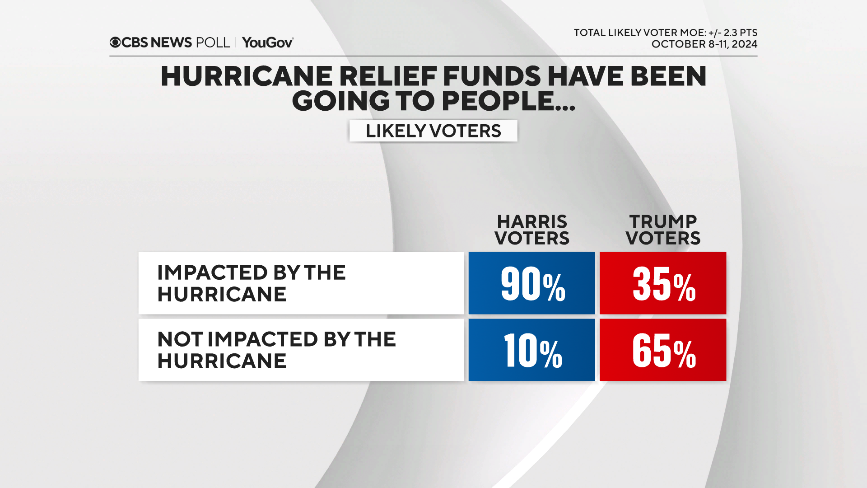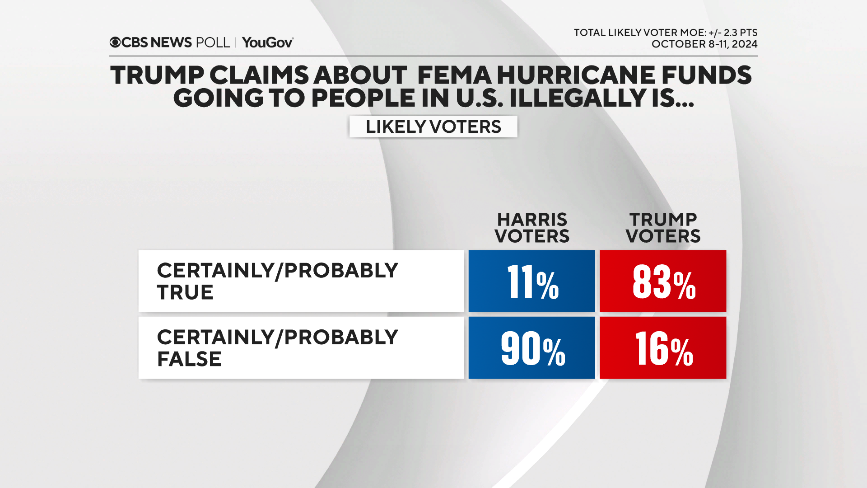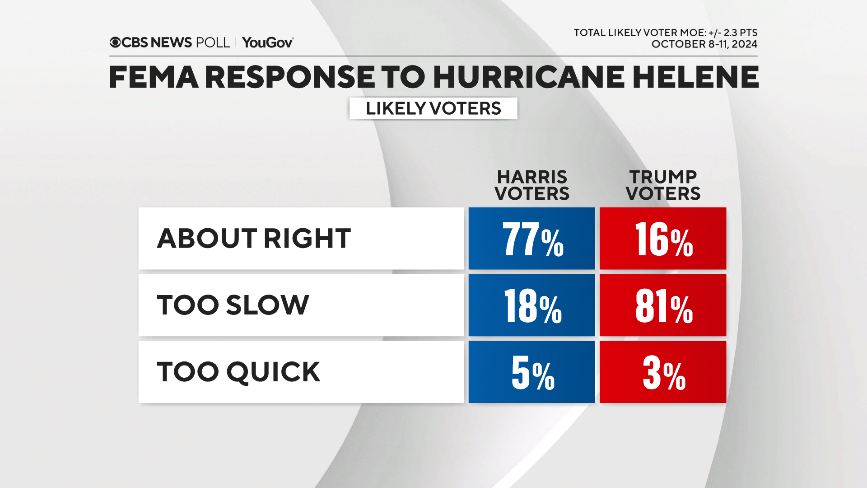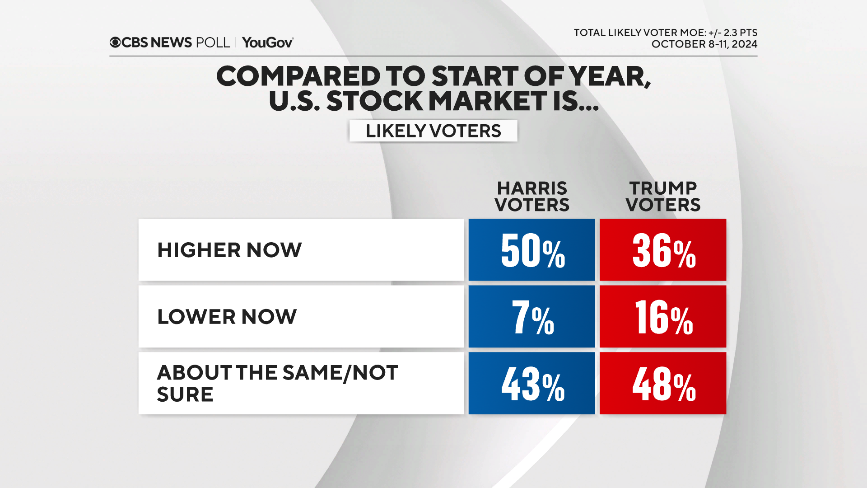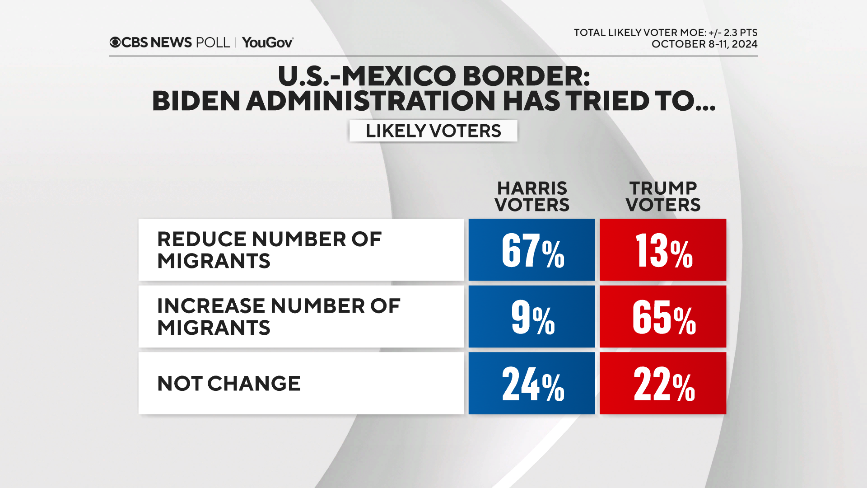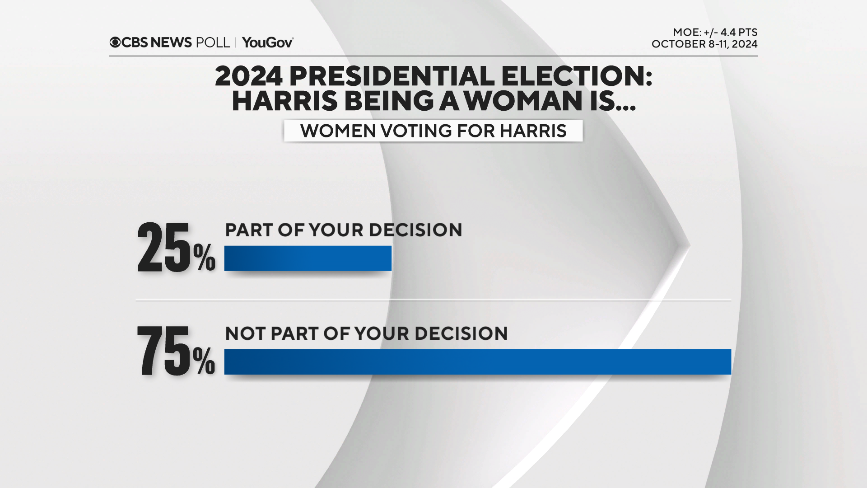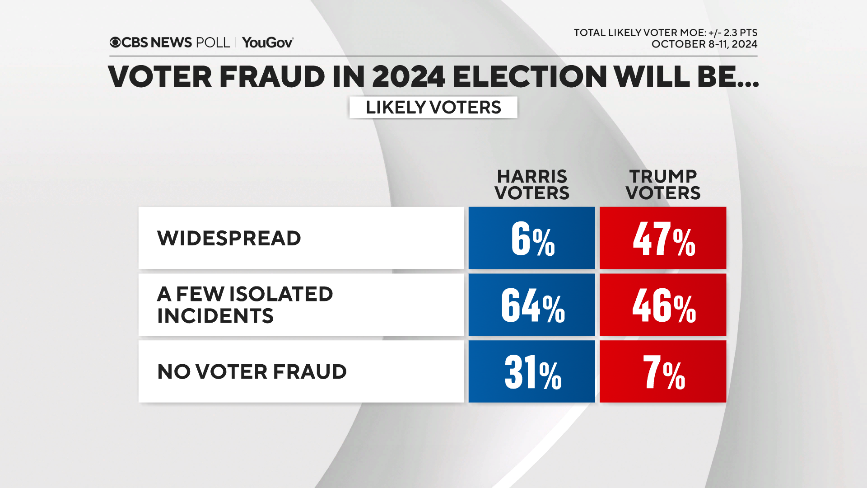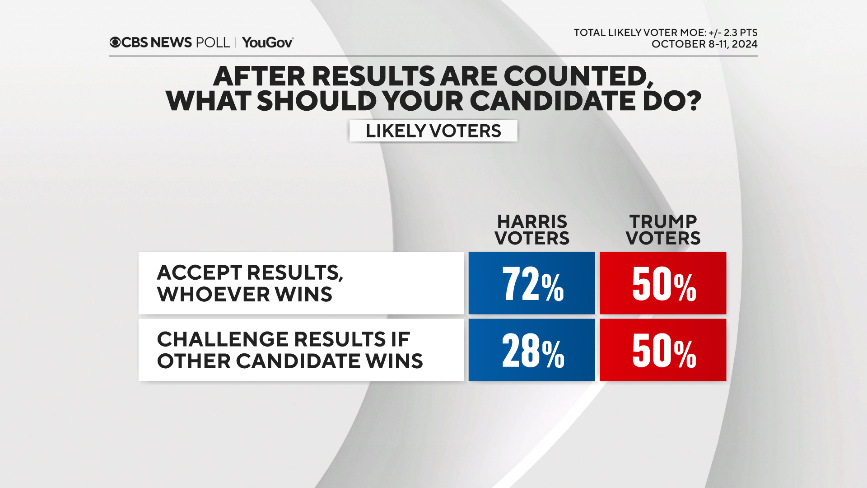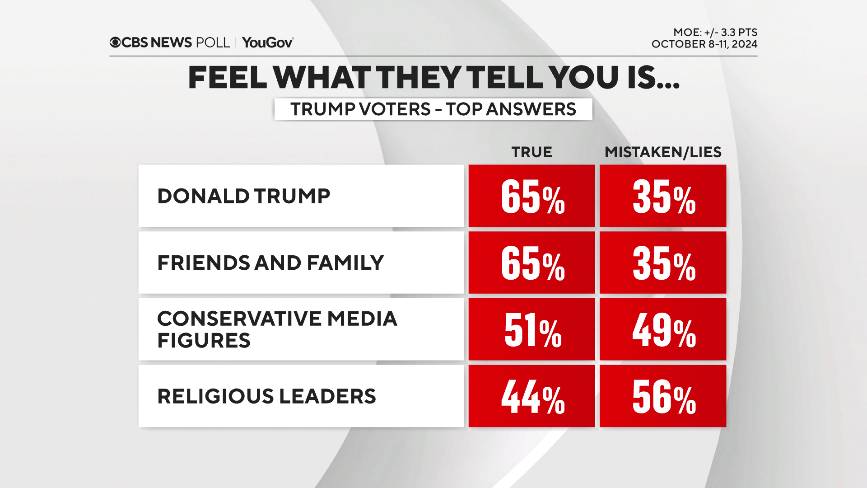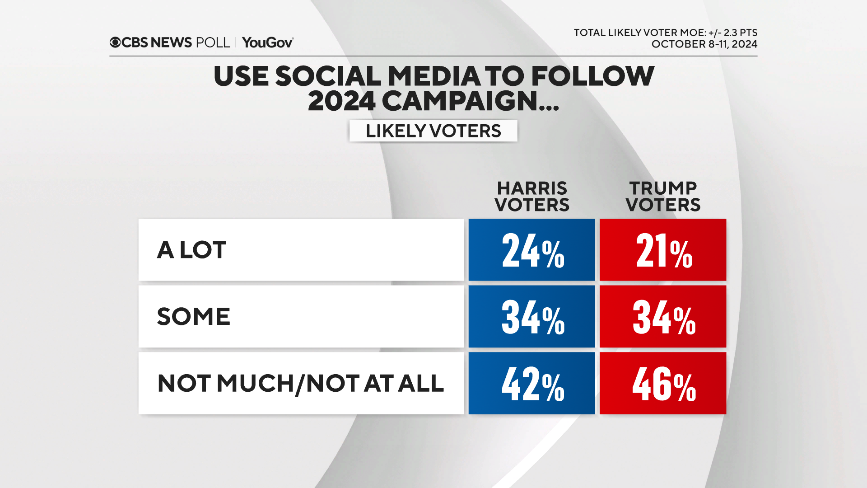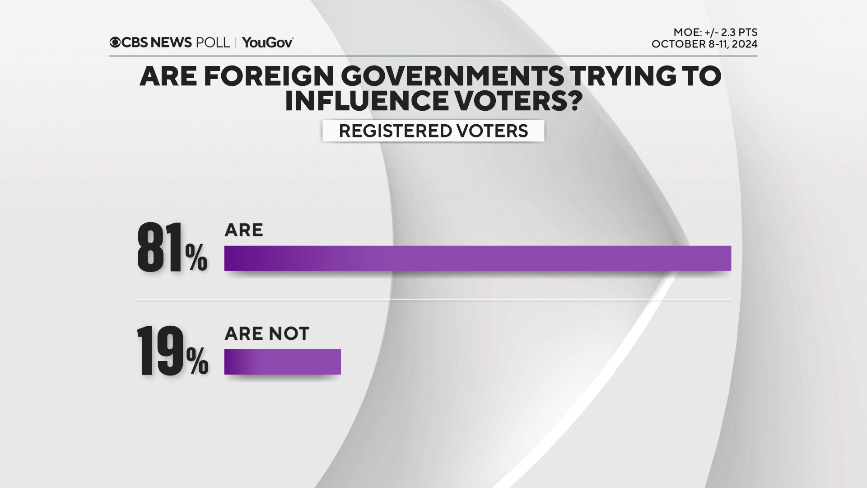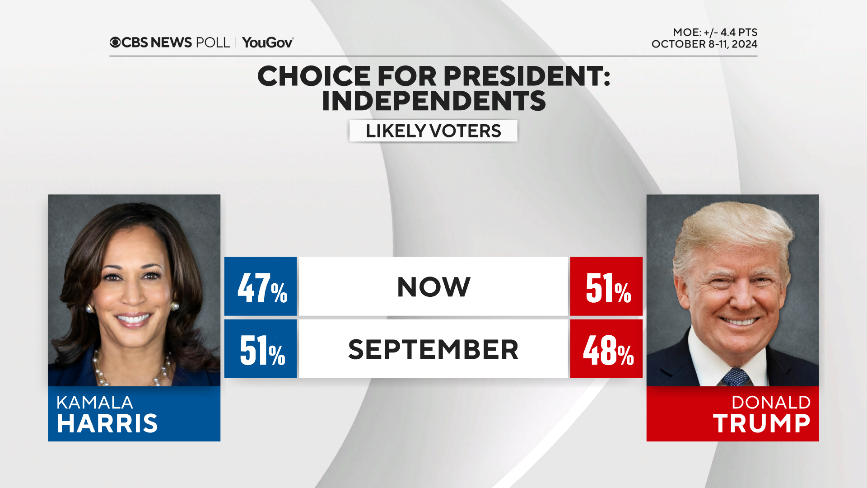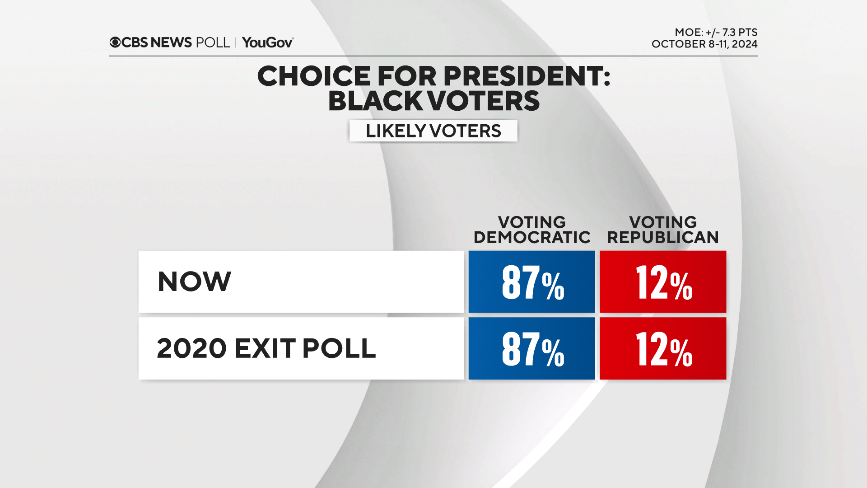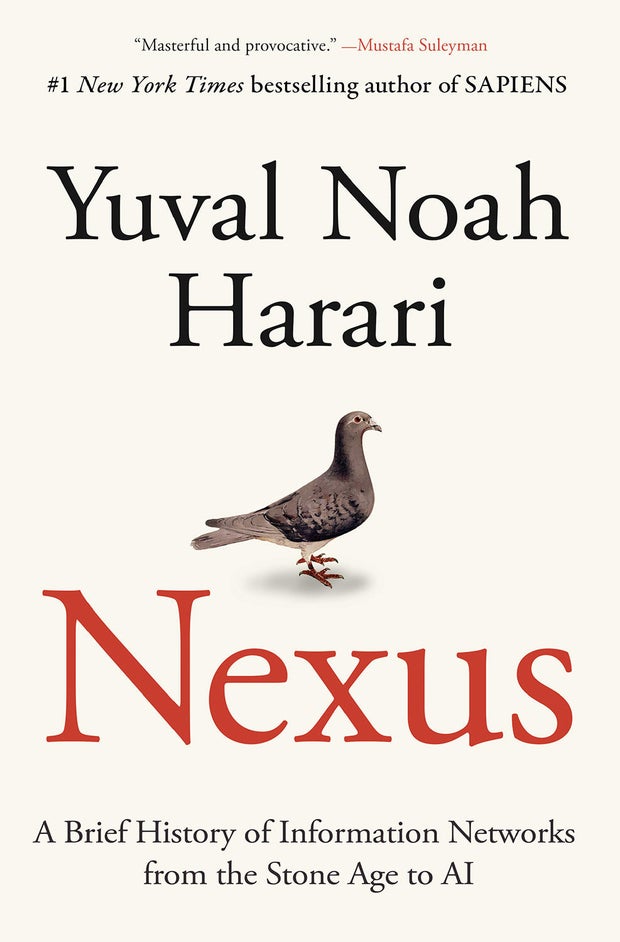CBS News
Here Comes the Sun: Carl Hiaasen and more

Watch CBS News
Be the first to know
Get browser notifications for breaking news, live events, and exclusive reporting.
CBS News
CBS News Trump-Harris poll shows one election, two worlds: How information, beliefs shape tight campaign

The 2024 presidential contest between Kamala Harris and Donald Trump is more than just two ideologies competing over what should happen. It’s two groups of voters that look out at the country and don’t even agree on what’s happening right now.
Views about hurricane relief are just one example of many. To most of former President Donald Trump’s voters, that relief isn’t going to the people impacted. To Vice President Kamala Harris’ voters, it is.
Trump’s voters view the U.S. economy as bad, while most Harris voters view the economy as good. Trump’s voters say U.S.-Mexico border crossings are increasing now. Harris’ voters are more apt to say crossings are down than up. As voting gets underway, far more Trump voters anticipate widespread fraud. Harris’ voters do not.
And Trump’s voters — especially the men among them — see themselves in a nation where gender equality efforts have gone too far. For most Harris voters gender equality efforts in the U.S. haven’t gone far enough.
There is at least one thing in common though: each side says they use but don’t trust social media. They say that it makes it easier for them to find people they agree with (perhaps reinforcing already-held beliefs) but also harder to tell what’s true.
Against that backdrop, an already close, effectively even contest draws even tighter. Trump is one point closer to Harris nationally than last month, the decisive battleground states also remain effectively even, a mere one point apart now.
What’s happening with hurricane relief?
In the view of most Trump voters, hurricane relief is mainly going to people not impacted by hurricanes, and among them, there’s wide belief in the claim that FEMA funds are going to people in the U.S. illegally.
Most Harris voters think those claims are false, that funds are going to people impacted and relief efforts are moving about the right speed.
What’s happening in the economy now?
On the economy, which often reveals partisan-driven differences, Trump voters overwhelmingly call it bad at the same time most Harris voters call it good.
Even if that’s somewhat subjective, there are differences between the camps in what they see on other related measures. Trump voters are less apt than Harris voters to say the stock market is up for the year and less likely to say the U.S. has added jobs of late, though for voters who express a direction, the net balance in both camps is a higher market and more jobs. The perceived implications of that are apparently different, however.
Harris voters are also less likely to think prices are increasing.
What’s happening at the border now?
On the U.S.-Mexico border, Harris’ voters are more inclined to think the number of migrant crossings is decreasing. But Trump’s voters are relatively more apt to say crossings are increasing today and that the Biden administration has in fact tried to increase, not reduce, them.
Illegal crossings at the southern border in September reached their lowest levels since the beginning of the Biden administration.
When we follow up with voters who think President Biden tried to increase crossings, and ask why, the top answer picked by Trump voters is that they suspect there are efforts to get migrants to vote illegally in U.S. elections.
Gender differences and equality efforts
There are big differences evaluating some cultural or social shifts, which may help partly explain the gender gap, however large it ends up being:
Most Trump voters see efforts to promote gender equality in the U.S. going too far (men backing Trump especially think so) while Harris voters think those efforts aren’t going far enough, especially the women backing her.
For a quarter of women backing Harris, the fact that she is a woman is a part of their decision-making.
For 10% of men backing Trump, the fact that Harris is a woman is a factor in theirs.
What may happen with the election system?
As voting begins in many states, voters generally trust their states’ election system, but Trump’s voters are much more skeptical.
Only a quarter of voters think there will be widespread fraud. Harris voters don’t think so, but nearly half of Trump voters do.
Amid all of this, half of Trump voters want him to challenge the election results if Harris wins. Most of Harris’ backers want her to accept the results, no matter who wins.
Who do you trust for information?
Bigger picture, on who voters trust for truthful information: For Donald Trump’s voters, Trump himself is a top source as much as their own family and friends, though they don’t show overwhelming trust in a lot of sources presented. Trump does rank more highly than other conservative media figures generally; medical scientists in general; and far more than government economic reports.
Harris’ voters, in turn, trust Harris even more than Trump voters trust Trump, but Harris backers are also relatively much more trusting generally of sources, including medical scientists and government reports.
Both sides share a mistrust of corporate leaders and social media influencers, and each side says they use social media to follow the campaign at about the same rate.
And something else supporters of the candidates share: the overwhelming suspicion that foreign governments are trying to influence the election. Most also believe that foreign governments are supporting threats or attempts to harm U.S. presidential candidates.
Voters overall tend to suspect that China and Iran want Harris to win and that Russia wants Trump to win – but within those numbers, each side thinks those foreign countries want the other candidate to win. Trump voters think Russia wants Harris; Harris voters think Russia wants Trump.
What’s happening with voter groups?
Amid all this, it is perhaps little surprise that neither candidate can effect large swings. The national preference between the two is still essentially even, as it has been since August, with a one-point move back toward Trump both nationally and in the battlegrounds composite. Behind that, independents have shifted a little now toward Trump.
Black voters are still voting heavily Democratic, as in past years, right now supporting Harris at the same rate as they did Mr. Biden in 2020. However, the likelihood of turnout for Black voters lags that of White voters, suggesting perhaps there is more for Harris’ campaign to do in activating these voters.
Neither candidate has the edge on the ability to handle a federal response to natural disasters. Just about a third of voters have a lot of confidence in either Harris or Trump on this.
Voters think Harris is more likely to make access to affordable health care better rather than worse, while more think Trump would make access worse.
On abortion: when voters say this is a major factor, Harris enjoys some of her widest margins over Trump. However, over the course of the campaign, the number who rank it as a major factor has not grown.
Also, her campaign’s argument that Trump will try to ban abortion nationally has not resonated with most voters outside of her own party. Most independents, along with Republicans, think Trump will leave the matter of abortion to the states.
On taxes, Trump has the advantage. Voters are twice as likely to say Harris will make their taxes go up rather than down — and this is true among all income groups. Voters are more divided on what will happen with their taxes under Trump.
This CBS News/YouGov survey was conducted with a representative sample of 2,719 registered voters nationwide interviewed between October 8-11, 2024. The sample was weighted according to gender, age, race, and education based on the U.S. Census American Community Survey and the U.S. Census Current Population Survey, as well as past vote. Respondents were selected to be representative of registered voters nationwide. The margin of error for registered voters is ±2.3 points. Battlegrounds are AZ, GA, MI, NC, NV, PA, and WI.
CBS News
SpaceX pulls off unprecedented feat, grabs descending rocket with mechanical arms

In one of the most dramatic, high-risk space flights to date, SpaceX launched a gargantuan Super Heavy-Starship rocket on an unpiloted test flight Sunday and then used giant “mechazilla” mechanical arms on the pad gantry to grab the descending first stage out of the sky as the upper stage continued to space.
The spectacular capture, using pincer-like arms more familiarly known as chopsticks, represented a new milestone in SpaceX’s drive to develop fully reusable, quickly re-launchable rockets. It is a technological tour de force unmatched in the history of earlier space programs relying on expendable, throw-away rockets.
The 397-foot-tall rocket blasted off from SpaceX’s Boca Chica, Texas, flight facility on the Texas Gulf Coast at 8:25 a.m. EDT, putting on a spectacular sunrise show as the booster’s 33 methane-burning Raptor engines ignited with a ground-shaking roar and a torrent of flaming exhaust.
Three minutes and 40 seconds after liftoff, the Super Heavy booster fell away, flipped around and restarted 13 Raptors to reverse course and head back toward the Texas coast as the Starship upper stage continued the climb to space on the power of its six Raptor engines.
The booster’s flight computer was programmed to direct the stage to a splashdown in the Gulf of Mexico if any problems developed on the rocket or the launch pad capture mechanism.
But no such problems were detected and the Super Heavy continued toward its launch pad, descending and then slowing to a near hover between the two mechanical arms, which then moved in to grab the rocket as its engines shut down. SpaceX employees at the company’s headquarters in Hawthorne, Calif., burst into cheers and applause.
The remarkable capture, a key element in SpaceX founder Elon Musk’s drive to achieve “rapid reusability,” came as the Starship upper stage was still heading to space and splashdown in the Indian Ocean, simulating a touchdown on shore or, eventually, on the moon or Mars. Splashdown was expected an hour and five minutes after liftoff.
During the rocket’s fourth test flight in June, the extreme temperatures caused significant damage to the Starship’s protective tiles and steering fins. Multiple upgrades and improvements were put in place for Sunday’s flight to eliminate or minimize any such re-entry damage.
The two-stage Super Heavy-Starship, known collectively as the Starship, is the largest, most powerful rocket in the world with twice the liftoff thrust of NASA’s legendary Saturn 5 and nearly twice the power of the agency’s new Space Launch System moon rocket.
The 30-foot-wide Super Heavy first stage, loaded with 6.8 million pounds of liquid oxygen and methane propellants, stands 230 feet tall and is powered by 33 SpaceX-designed Raptor engines generating up to 16 million pounds of thrust. The Starship upper stage measures 160 feet long and carries 2.6 million pounds of propellant to power another six Raptors.
Both stages are designed to be fully reusable, with the Super Heavy flying itself back to its launch pad while the Starship travels to and from Earth orbit, the moon, or, eventually, Mars. The Starship is designed to touch down vertically on its own rocket power at landing sites on Earth and beyond.
But the primary goal of Sunday’s flight was to demonstrate the ability to capture returning Super Heavy boosters on the launch pad where they can be quickly refurbished, refueled and relaunched.
SpaceX perfected first-stage landings with its workhorse Falcon 9 rockets, successfully recovering 352 such boosters to date with powered touchdowns on landing pads or off-shore droneships. The smaller Falcon 9 first stages land on their own, deploying four landing legs a few seconds before touchdown.
Snatching the 230-foot-tall Super Heavy out of the sky with mechanical arms as the rocket descends and hovers right beside its launch gantry seemed an outlandish idea when it was first proposed during the booster’s initial development.
But SpaceX engineers “spent years preparing and months testing for the booster catch attempt, with technicians pouring tens of thousands of hours into building the infrastructure to maximize our chances for success,” the company said on its website.
“With each flight building on the learnings from the last, testing improvements in hardware and operations across every facet of Starship, we’re on the verge of demonstrating techniques fundamental to Starship’s fully and rapidly reusable design,” the company continued.
SpaceX is under contract with NASA to supply a modified Starship to carry astronauts to landings near the moon’s south pole in the agency’s Artemis program.
To get a Starship lander to the moon, SpaceX must first get it into low-Earth orbit, then launch multiple Super Heavy-Starship “tankers” to refuel the moon-bound Starship for the trip to lunar orbit.
The astronauts will launch atop NASA’s Space Launch System rocket and fly to the moon aboard a Lockheed Martin-built Orion capsule. The crew will transfer to the waiting Starship for the descent to the lunar surface. NASA hopes to send the first woman and the next man to the moon in the 2027-28 timeframe, after an unpiloted Starship moon landing.
Rapid reusability is a key element of the program given the number of Super Heavy-Starships that will be required for a single moon landing. While Sunday’s test flight appeared to go smoothly, multiple flights will be needed to perfect the system and demonstrate the reliability required to carry astronauts.
How long that might take is an open question.
Over the past few weeks, Musk has launched a social media broadside against the Federal Aviation Administration, complaining that the agency’s bureaucracy takes too long to review and approve launch licenses and is, in effect, stifling innovation and slowing the development of the new rocket system.
The FAA did not grant a license to launch Sunday’s test flight until the day before. But this time around, the license covered multiple test flights using roughly the same flight plan.
CBS News
The Book Report: Washington Post critic Ron Charles (October 13)

By Washington Post book critic Ron Charles
Here are four great new books to sink into this fall.
W.W. Norton
The Pulitzer Prize-winning novelist Richard Powers is back with “Playground” (W.W. Norton), a brilliant new novel about artificial intelligence and the race to save the oceans.
The story moves along three tracks: There’s a computer genius looking back at his life; an oceanographer recounting her love for sea creatures; and a small group of people on a tiny island in the South Pacific who’ve been offered a fortune by a shadowy group of tech billionaires.
How Powers manages to draw these three stories together will change the way you see the world.
Read an excerpt: “Playground” by Richard Powers
“Playground” by Richard Powers (W.W. Norton), in Hardcover, eBook and Audio formats, available via Amazon, Barnes & Noble and Bookshop.org
Richard Powers (Official site)
Scribner
“Creation Lake” by Rachel Kushner (Scribner) looks like a spy thriller, but it’s even trickier than that. The narrator is a freelance agent who specializes in infiltrating radical groups.
She’s been hired to pose as a translator in France and work her way into a commune of environmental terrorists who follow a spiritual leader who believes we should live more like the Neanderthals once did.
But as she gets closer to sabotaging this group, she falls under the spell of this Neanderthal philosophy.
Read an excerpt: “Creation Lake” by Rachel Kushner
“Creation Lake” by Rachel Kushner (Scribner), in Hardcover, Large Print, eBook and Audio formats, available via Amazon, Barnes & Noble and Bookshop.org
Rachel Kushner (Official site)
Riverhead
Danzy Senna’s “Colored Television” (Riverhead Books) is a sharp, witty satire of our attitudes about racial identity and pop culture.
At the center of the story is a writer who spent years working on a vast history of biracial people, only to discover that nobody will publish it. And so, desperate for money, she turns to Hollywood and tries to sell her idea for a biracial TV sit-com.
But what would that be, and why would it be funny? That remains a mystery, but this is a wickedly funny novel about trying to make it in America.
Read an excerpt: “Colored Television” by Danzy Senna
“Colored Television” by Danzy Senna (Riverhead Books), in Hardcover, Large Print, eBook and Audio formats, available via Amazon, Barnes & Noble and Bookshop.org
Random House
Yuval Noah Harari is a genius at helping people imagine and comprehend enormous spans of time. A decade ago, he published a bestseller called “Sapiens: A Brief History of Humankind.”
And now, his new book – “Nexus: A Brief History of Information Networks from the Stone Age to AI” (Random House) – looks at the way information was used to control past human societies, and how artificial intelligence is already reshaping our world.
“Silicon chips,” he warns, “can create spies that never sleep, financiers that never forget, despots that never die. How will this change society, economics, politics?”
Read an excerpt: “Nexus” by Yuval Noah Harari
“Nexus: A Brief History of Information Networks from the Stone Age to AI” by Yuval Noah Harari (Random House), in Hardcover, Large Print, eBook and Audio formats, available via Amazon, Barnes & Noble and Bookshop.org
Yuval Noah Harari (Official site)
For more suggestions on what to read, contact your librarian or local bookseller.
That’s it for the Book Report. I’m Ron Charles. Until next time, read on!
For more info:
For more reading recommendations, check out these previous Book Report features from Ron Charles:
Produced by Robin Sanders and Roman Feeser.



